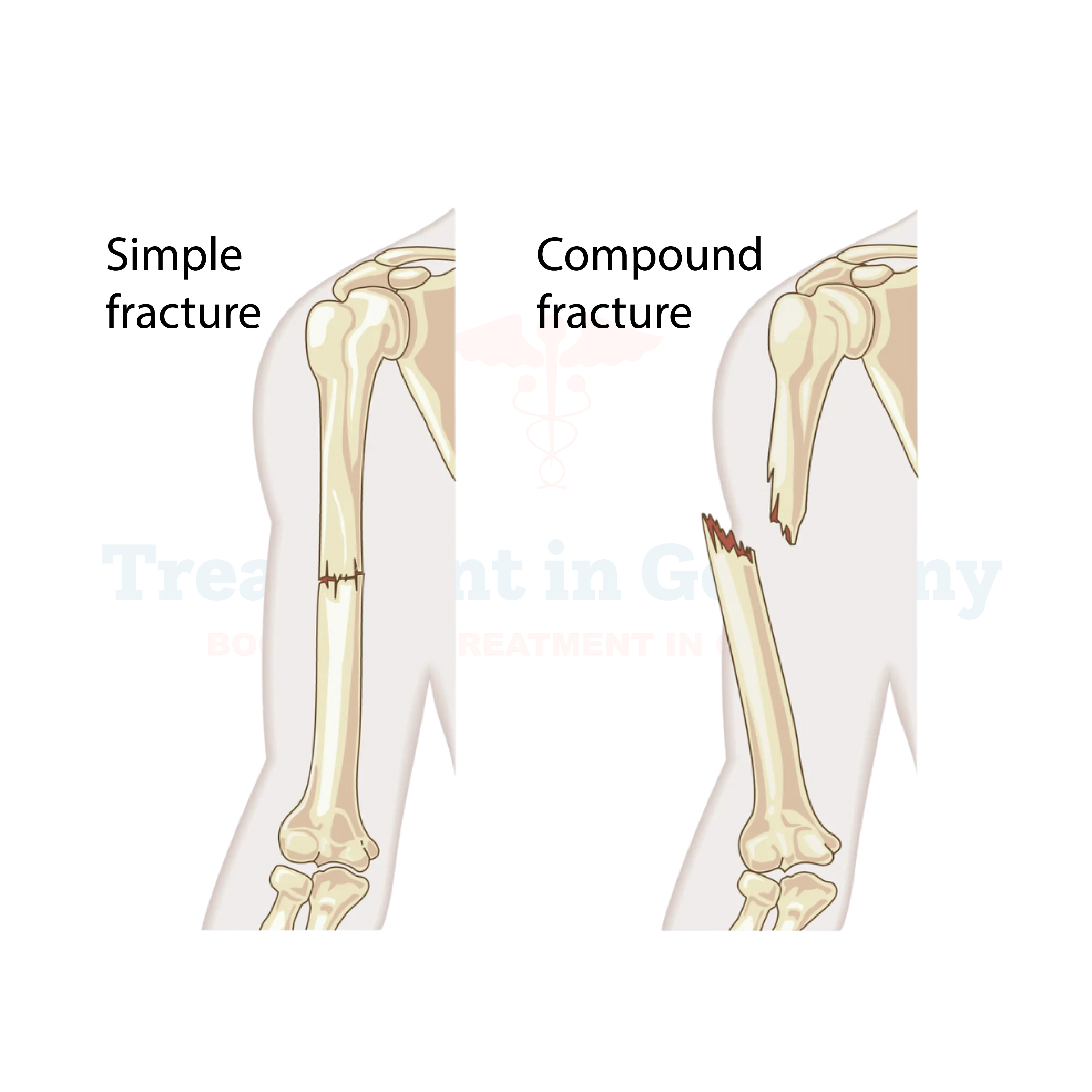A fracture, commonly known as a broken bone, occurs when there is a break in the continuity of a bone due to excessive force, trauma, or underlying medical conditions such as osteoporosis. Fractures can range from minor cracks to complete breaks that require immediate medical attention. They are classified based on their severity, location, and cause. Proper diagnosis and treatment are crucial to ensure effective healing and prevent complications.
Germany has become a leading destination for fracture treatment due to its advanced medical facilities, experienced orthopedic specialists, and innovative treatment methods such as stem cell therapy, neurostimulation therapy, and regenerative medicine. German hospitals provide world-class care, making them an excellent choice for patients seeking the best possible treatment outcomes.
Fractures are categorized based on their characteristics and underlying causes:
Closed (Simple) Fracture: The bone breaks but does not penetrate the skin.
Open (Compound) Fracture: The broken bone pierces through the skin, increasing infection risk.
Greenstick Fracture: Common in children, where the bone bends and partially breaks.
Comminuted Fracture: The bone shatters into multiple pieces.
Stress Fracture: Caused by repeated strain, often seen in athletes.
Pathological Fracture: Occurs due to weakened bones from diseases like osteoporosis or cancer.
Transverse Fracture: A horizontal break across the bone.
Oblique Fracture: A diagonal break in the bone.
Spiral Fracture: Twisting force causes a spiral-shaped break, common in sports injuries.
Risk Factors for Fractures
Several factors increase the risk of fractures, including:
Osteoporosis: Weakens bones, making them prone to fractures.
Obesity and High BMI: Increased weight puts stress on bones and joints.
Diabetes: Affects bone health and slows down healing.
Autoimmune Diseases: Conditions like rheumatoid arthritis weaken bones.
Vitamin D and Calcium Deficiency: Leads to brittle bones.
Aging: Bone density decreases with age, increasing fracture risk.
High Cholesterol (Hyperlipidemia): Affects bone remodeling and healing.
Sports Injuries: High-impact activities put bones at risk of fractures.
Accidents and Falls: A common cause, especially in elderly individuals.
Symptoms of Fractures
The symptoms of fractures vary based on severity but typically include:
Severe pain at the injury site
Swelling, bruising, and tenderness
Deformity or misalignment of the affected area
Inability to move the affected limb
Grinding or cracking sounds at the time of injury
Open wounds (in compound fractures)
Loss of function in the affected area
Diagnosis & Diagnostic Tools in Germany
Accurate diagnosis is crucial for determining the best treatment plan. Hospitals in Germany use state-of-the-art diagnostic tools, including:
X-rays: The primary imaging method to detect fractures and bone abnormalities.
MRI (Magnetic Resonance Imaging): Provides detailed images of soft tissues and bone structures.
CT (Computed Tomography) Scans: Creates 3D images for complex fractures.
Bone Density Tests: Assesses bone strength, especially in osteoporosis-related fractures.
Blood Tests: Helps detect underlying conditions affecting bone health.
Treatment of Fractures in Germany
Germany is at the forefront of fracture treatment, offering advanced surgical and non-surgical solutions.
Conventional Treatments
Immobilization (Casting & Splinting): For minor fractures, allowing natural healing.
Traction: Uses weights and pulleys to align bones.
Physical Therapy: Restores mobility and strength after healing.
Pain Relievers & Anti-inflammatory Medications: Helps manage pain and swelling.
Surgical Treatments
Open Reduction and Internal Fixation (ORIF): Uses metal plates, screws, or rods to stabilize fractures.
External Fixation: A metal frame outside the body stabilizes severe fractures.
Bone Grafting: Used for severe fractures where bone regeneration is required.
Joint Replacement Surgery: For fractures affecting joints like the hip or knee.
Innovative Therapies in Germany
Germany offers cutting-edge treatments for faster and more effective fracture recovery:
Stem Cell Therapy: Promotes bone regeneration and speeds up healing.
Platelet-Rich Plasma (PRP) Therapy: Uses the patient’s blood to enhance healing.
Neurostimulation Therapy: Helps manage chronic pain associated with fractures.
Dendritic Cell Therapy: Enhances immune function to support recovery.
Regenerative Medicine: Uses advanced biological treatments to repair damaged bone tissue.
3D Printing in Orthopedics: Custom implants for complex fractures.
Why Choose Germany for Fracture Treatment?
Germany is a leading medical destination due to its:
Top-Rated Hospitals: Equipped with the latest technology and world-class facilities.
Expert Surgeons and Specialists: Highly experienced in complex fracture treatments.
Multidisciplinary Approach: A combination of orthopedic, physical therapy, and regenerative medicine specialists.
Personalized Treatment Plans: Tailored for each patient to ensure the best recovery.
Shorter Recovery Time: Due to innovative therapies and high-quality rehabilitation.
Medical Tourism-Friendly Services: International patients receive seamless treatment and care.
Solutions & Prevention of Fractures
Preventive Measures
Maintain Bone Health: Consume calcium and vitamin D-rich foods.
Exercise Regularly: Weight-bearing exercises strengthen bones.
Avoid Smoking & Alcohol: These weaken bone density.
Use Protective Gear: Essential for athletes and high-risk jobs.
Regular Bone Density Screenings: Helps in early detection of osteoporosis.
Fall Prevention Strategies: Especially for elderly individuals.
Complementary Therapies for Recovery
Chiropractic Care: Helps align the musculoskeletal system.
Massage Therapy: Reduces muscle stiffness and improves circulation.
Hydrotherapy: Supports rehabilitation and pain relief.
Herbal Supplements: Natural remedies to support bone healing.
Conclusion
Fractures require prompt and effective treatment to ensure proper healing and prevent complications. Germany’s hospitals and specialists offer cutting-edge solutions, from traditional orthopedic care to innovative regenerative treatments like stem cell therapy and PRP therapy. The combination of expert medical teams, state-of-the-art diagnostic tools, and personalized rehabilitation programs makes Germany one of the best destinations for fracture treatment.
By taking preventive measures and seeking the best possible medical care, individuals can recover quickly and regain mobility without long-term complications.
👉 Contact us for further information and receive a complimentary consultation.

.webp)
.webp)
 (1).webp)
 (1).webp)

.webp)
.webp)
 (1).webp)
 (1).webp)
